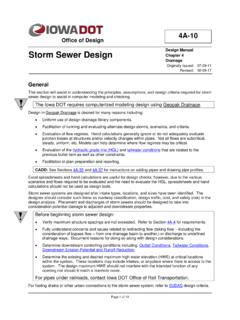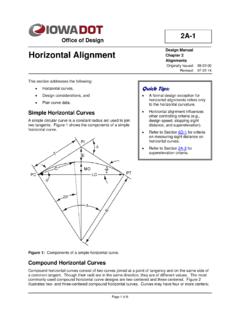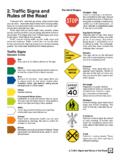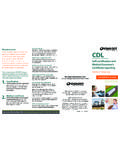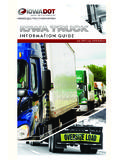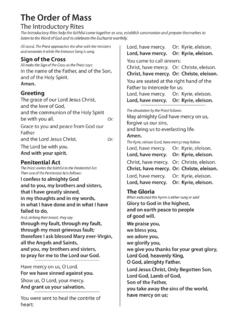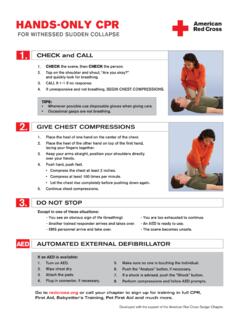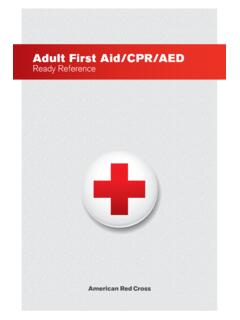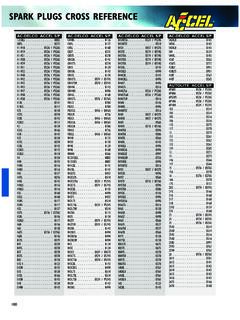Transcription of Chapter 2A-8 - Sign Placement
1 Page 1 of 17 Originally Issued: 12-17-01, Last Revised: 05-08-13 TRAFFIC AND SAFETY MANUAL Chapter 2 Signing 2A - General Signs should be located on the right side of the roadway where they are easily recognized and understood by road users. Signs in other locations should be considered only as supplementary to signs in the normal locations, except as otherwise indicated in the Traffic and Safety Manual or the Manual on Uniform Traffic Control Devices (MUTCD). Supplementary warning signs are used on the left of the roadway on multilane divided roads since traffic in the right lane might obstruct the view to the right. Signs should be individually installed on separate posts or mountings except where one sign supplements another or where route or directional signs must be grouped.
2 Where space is limited, certain signs may be mounted together or omitted. The State Traffic Engineer will provide assistance for individual cases at the request of the District Office. Longitudinal Placement The locations of some signs are fixed such as points where speed limits change, no passing zones begin, corporate limits cross a primary road and at intersections. A reasonable amount of flexibility is afforded in the location of many other warning and guide signs. When selecting locations, surrounding features and terrain should be carefully examined. First, the roadway cross section should be considered. Select a location where the sign can be offset the desired distance without encountering a severe fill section requiring long posts or a cut section where the sign cannot be offset at the proper mounting height.
3 If available, a relatively level section is preferred. Locations behind existing guardrails or barriers should be considered to take advantage of protected areas. Next, check to see if there are physical features that may obstruct visibility of the sign . Examples are trees, mailboxes, vertical or horizontal curves, utility or luminaire poles, bridge piers and abutments and other essential signs. Locations must be adjusted to points where these features are not obstructions. In some cases, it may be necessary to clear obstructions. Care should be taken to see that the shape or outline of a sign is not obscured when mounting signs back to back. Do Not Enter and Wrong Way signs at interchange ramps may be mounted on the back of Stop and Destination signs respectively if this does not obscure the outline of the signs.
4 For most other back-to-back locations, signs should be located on separate posts at a minimum of 50-foot spacing. Normally, the minimum longitudinal spacing of signs is 300 feet on two-lane and four-lane undivided roadways and 800 feet for four-lane divided roadways. At intersections and in urban areas where room is limited, it may be necessary to reduce spacing. In sections with reduced speed limits, spacing of five times the posted speed limit is desirable, but conditions may limit spacing to as little as three times the posted speed limit. Uniform spacing enhances the effectiveness of a series of signs. Where practical, the typical spacing for Interstate and Freeway Routes should be 1000 feet or more. Spacing is important to allow signs to be viewed without obstructing one another and to allow the motorist time to read and understand the message conveyed before encountering another sign .
5 2A-8 sign Placement Iowa Department of Transportation Office of Traffic & Safety Chapter 2 Signing 2A General Page 2 of 17 2A-8 sign Placement Since warning signs are primarily for the benefit of the driver who is unacquainted with the road, it is very important that care be given to the Placement of such signs. Warning signs should provide adequate time for the driver to perceive, identify, decide, and perform any necessary maneuver. This total time to perceive and complete a reaction to a sign is the sum of the times necessary for Perception, Identification (understanding), Emotion (decision making) and Volition (execution) of a decision, and is here referred to as the PIEV time. The PIEV time can vary from about 3 seconds for general warning signs to 10 seconds for high driver judgment condition warning signs.
6 Table 1 lists suggested minimum sign Placement distances that may be used for three conditions. Condition A is a high driver judgment condition which requires the driver to use extra time in making and executing a decision because of a complex driving situation such as lane changing, passing or merging. Typical signs are Merge, Lane Reduction, Added Lane, Right Lane Ends, and Divided Road Ends. Condition B is a condition in which the driver will likely be required to stop. Typical signs are Stop Ahead, Signal Ahead and Low Clearance. Condition C is a condition in which the driver will likely be required to decelerate to a specific speed. Typical signs are Turn, Curve, Bump, Dip and cross Road. Table 1 is provided as an aid for determining warning sign locations.
7 The values contained in the table are for guidance purposes and should be applied with engineering judgment. Table 1 Guidelines for Advance Placement of Warning Signs Posted or 85th percentile speed MPH (use higher speed) Suggested Minimum Placement Distance (Feet) (1) (2) Condition A high judgment needed (10 Secs. PIEV) General Warning Signs Condition B STOP condition Condition C Deceleration conditions to listed advisory speed or desired speed at condition (MPH) 10 20 30 40 50 20 175 -(3) -(3) 25 250 -(3) 100 -(3) 30 325 100 150 100 35 400 150 200 175 -(3) 40 475 225 275 250 175 45 550 300 350 300 250 -(3) 50 625 375 425 400 325 225 55 700 450 500 475 400 300 -(3) 60 775 550 575 550 500 400 300 65 850 650 650 625 575 500 375 Notes: (1) To determine the advance Placement distance, enter the table at the left using the approach speed, select the condition which applies, (A, B, or C) and read the distance in the column below.
8 (2) Distance provides for a 3-second PIEV, 175 feet sign Legibility Distance, Braking Distance for Condition B and Comfortable Braking Distance for Condition C. (3) No suggested minimum distance provided. At these speeds, sign location depends on physical conditions at the site. Other miscellaneous warning signs that advise of potential hazards not related to a specific location may be installed in the most appropriate locations since they are not covered in Table 1. These include Deer Crossing and Soft Shoulder signs for example. Chapter 2 Signing 2A General Page 3 of 17 2A-8 sign Placement Lateral Placement Signs on all newly constructed highways are to be offset from the traveled way if practical. This concept is to be extended to all signs that are replaced or are otherwise in need of attention by maintenance personnel.
9 The shape of the cross section, available right of way, maximum length of posts available and condition of the soil to resist wind load, control the permissible offset. Good signing practice requires that signs be at least 6 feet from the edge of the shoulder and at least 12 feet from the edge of the traveled way. Taking into consideration all of the above factors, offsets prescribed below should be used for all signs in rural areas except those in special categories covered later in this section. Type of Offset Minimum 18 feet Distance from Edge of Pavement to Near Post Desirable 24 feet Offsets should be measured from the edge of the pavement in all cases, regardless of the shoulder width. The offset distances are to the post for a single support assembly or the near post for a multiple support assembly.
10 Although the near edge of the sign projects closer to the roadway, offset distances will provide more than the minimum distances prescribed in the Manual on Uniform Traffic Control Devices. Depending on shoulder width these offsets will result in approximately 12 feet of clearance from the edge of the shoulder to the near edge of the sign . A distance of approximately 14 feet is provided from the shoulder edge to the signpost to provide a recovery area for errant vehicles, to allow for mowing and snow plowing, and to keep the signs cleaner. Figures 1 and 2 show typical minimum and desirable sign offsets for cut and fill sections in rural areas. Chapter 2 Signing 2A General Page 4 of 17 2A-8 sign Placement Figure 1 Chapter 2 Signing 2A General Page 5 of 17 2A-8 sign Placement Figure 2 Chapter 2 Signing 2A General Page 6 of 17 2A-8 sign Placement The desirable 24-foot offset (from the pavement) should be used in most normal cases.

